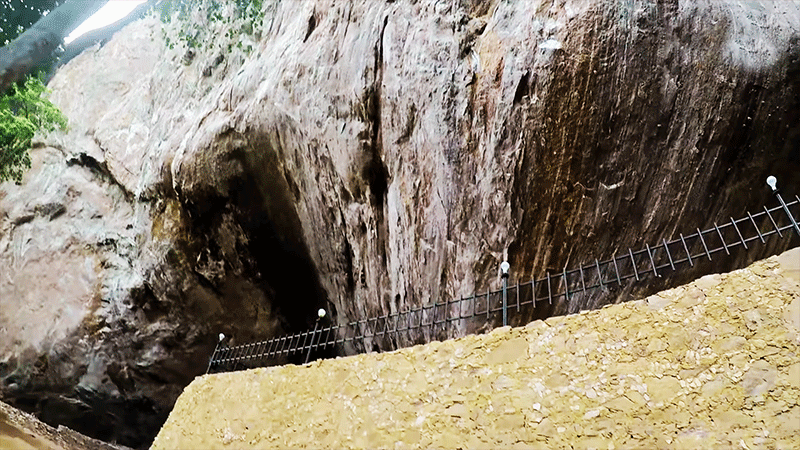A visit to the temple Aluvihare see diverse ancient scripts
The Aluvihare Rock Temple, also known as Matale Alu Viharaya, is a revered Buddhist temple that can be found in the city of Matale. The Aluvihara cave temple, which is surrounded by hills, is located 30 km north of Kandy on the Matale-Dambulla route. The temple was built in the 3rd Century B.C., under the reign of King Devanampiyatissa. After introducing Buddhism to the nation during his rule, it is said that the King constructed the dagoba, planted the Bo sapling, and established the temple.
Despite its very high historical and religious importance, the Aluvihare temple is rarely included in a Sri Lanka trip. Most Sri Lanka round-trip tours cover many historical places in the cultural triangle of Sri Lanka, but the Aluvihare temple is not part of most of these tour packages. Visiting Aluvihare temple is very rewarding. It is one of the oldest cave temples on the island, and visitors can witness dozens of ancient wall paintings as well as Buddha statues inside the temple.
The Pli Canon was originally written down at the Aluvihare temple. The Pali text was written on ola (palm) leaves at Aluvihare Rock Temple in ancient times. This temple is next to a number of monastery caves, some of which include ancient Buddhist paintings.
Background and significance
1896: Alu Vihare Temple
A 12-year famine known as “Baminithiyasaya” occurred in Sri Lanka in the first century BC, during the reign of King Walagamba. The South Indian invasion occurred at the same time, and the Buddhist monks of that period understood that these issues posed a threat to the continued survival of Buddha Sasana in the nation. The Dhamma (doctrine) was difficult to memorize and repeat under such conditions. The famine caused Buddhist monks to struggle and not get enough alms; in order to survive, they had to eat yams, tree roots, and leaves. A party of around 60 travelled to Malaya Rata, which is said to be the country’s hilly region. In spite of the difficult living circumstances, they managed to remain on the banks of the Mahaweli River for 12 years until the famine ended. After fourteen years, King Walagamba regained the throne by driving off the invaders who had ousted him due to a mutiny during the invasion from South India.
During the challenging time, the monks who had fled to India and the mountain regions of Sri Lanka came back to Anuradhapura and made the decision to write down the Tripiaka (Buddhist philosophical theories) for future generations to utilize and preserve. The Aluvihare Rock Temple in Matale was chosen by the monks as the most appropriate and safe location to conduct this significant ceremony. Because of the uncertainty brought on by recurrent South Indian invasions, this transcription was done out of concern that the teaching might be forgotten. In order to complete the challenging work of initially reciting the teachings and deciding on an acceptable version before transcription, it is reported that 500 learned monks gathered at the Aluvihare Rock temple. Ola leaf books, or puskola poth as they are called locally, were used for the whole transcribing. These books were bound in thick strips made from either talipot or palmyra leaves, and the teachings were written in the Pali language. The characters on the Ola leaves were written using a metal stylus.
Destruction of Aluvihare temple
During the Matale Rebellion in 1848, the ancient library at Aluvihare Rock Temple, which had carefully stored the volumes of these transcribed manuscripts for so many generations, was completely destroyed. This event also caused extensive damage to the temple complex. On the temple’s grounds, the effects of this catastrophe are still evident. The Tripiaka had to be recompiled, which took many years since it required many generations of monks. The first of the three “baskets of the law” was only finished in 1982, and the recompilation and transcription took a long time since so few monks were working on this laborious endeavour.
Ancient caves and ancient paintings
There are several caves with old inscriptions in the Aluvihare Rock Temple. These caves have amazing artwork on the walls and ceiling that is quite recent, as well as large Buddha sculptures and figures. Along with standing and sitting statues, the main cave of these has a huge reclining figure of the Buddha. There are horrifying portrayals of the horrible hereafter that await sinners near the entranceway of another cave that houses a reclining statue of the Buddha. One of the caves is devoted to the illustrious Indian monk-scholar Buddhagosa, who is considered the greatest exponent and interpreter of the Pali canonical texts. He lived in Anuradhapura in the 4th and 5th centuries and is said to have spent a number of years working on his academic studies in the Matale Alu Viharaya.
Etymology
The phrase Alu Vihara is connected to a lot of folklore and religious notions. Some claim that the name Aloka Vihara (temple of light) was changed to Aluvihara because the Pali word Aloka was known as Alu (light) in ancient Sinhalese. It was referred to as a Viharaya because it was a residence for Buddhist monks. Consequently, the two nouns were joined to form the phrase “Aluvihara.” Another viewpoint is that, despite the temple’s location in a rock cave with a large boulder to the east, sunlight is neither blocked nor obstructed by the rock. Aloka Lena (cave with light) was the name given to it as a result. But despite all of these perspectives and convictions, it is clear that the name of this temple has something to do with light.






